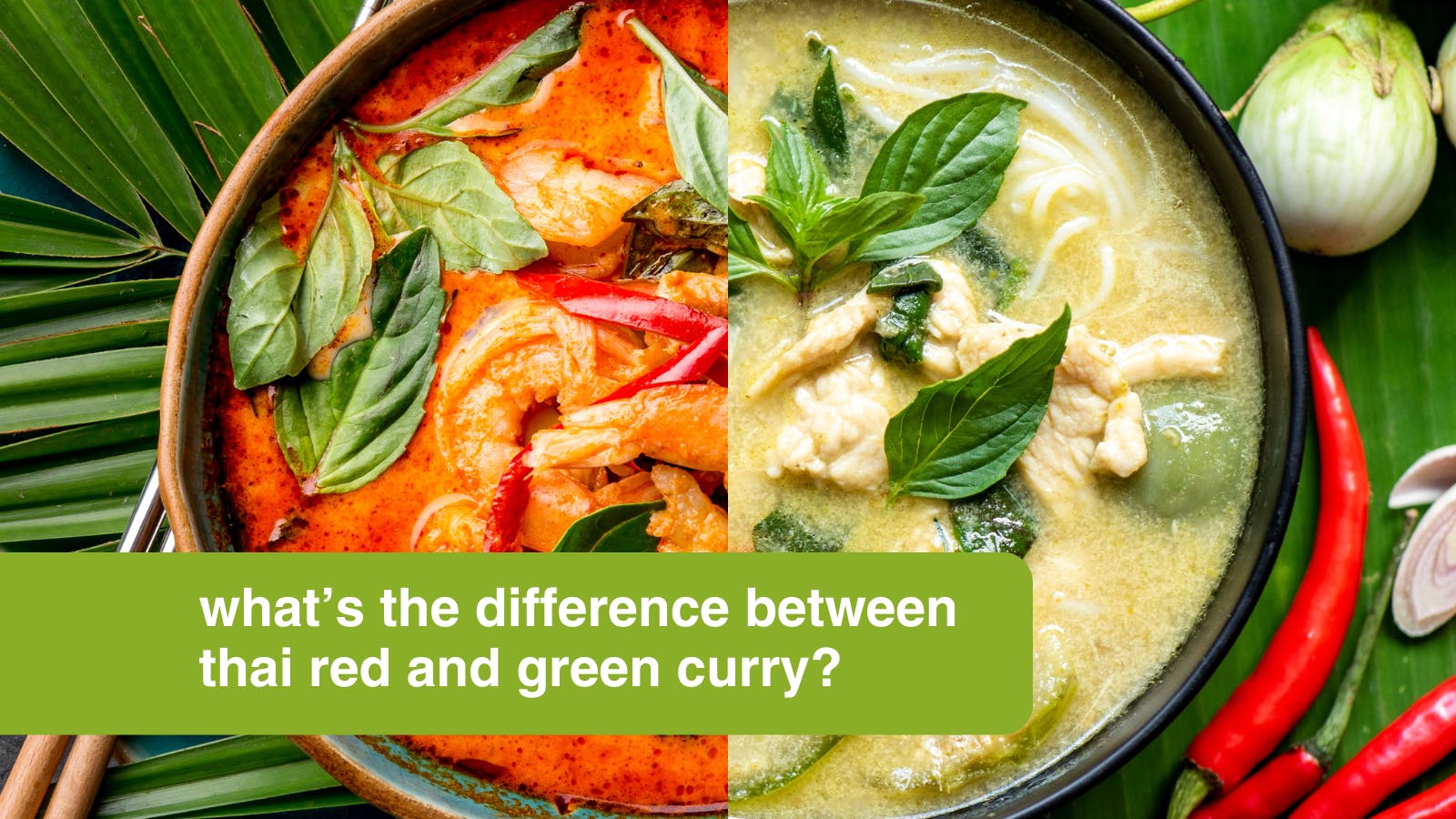your cart
Your cart is empty.
General Articles
What’s the Difference Between Thai Red and Green Curry?
Red and green Thai curries differ in more than just colour. Our breakdown consider how these classic dishes distinguish themselves.

Thai cuisine is particularly renowned for its fragrant, fiery curries, with red and green being two of the main types. Aside from differing in colour and visual appearance, these dishes have distinct flavour profiles and spice levels.
Not sure whether you’re team red or green? We break down the key differences between the two most popular Thai curry types – hint, it’s not just about the colour.
Differences Between Red & Green Thai Curries
While the colour is the most obvious difference between these curries, a closer look (and taste) shows how diverse and nuanced the classic Thai dish can be.
Spice Levels
The curries’ vibrant colour is primarily down to the kind of chillies used in the curry paste. Green Thai curry is made with fresh green chillies, while red curries are made with dried red chillies. The different types provide different levels of spice.
While you might assume that red equals extra hot and spicy (which is often the case with other foods), you’d be incorrect here, as, generally, green curries are spicier! The fresh green chillies used tend to be hotter, leading to dishes with a powerful kick. Spice levels can also depend on regional variation, as southern Thai green curries pack a particularly fiery punch because they use Bird’s Eye chillies.

Ingredients
The other ingredients in Thai curries also contribute to their characteristic colours and set them apart.
- Thai green curry: green chillies, lime leaves, coriander, basil, lemongrass and ginger.
- Thai red curry: red chillies, spices, galangal and shrimp paste.
Both curry types may use a range of vegetables (like peppers, bamboo shoots and aubergine), protein options and fragrant ingredients. There aren’t necessarily set rules about exactly what goes in each (aside from the chilli type), so you’ll come across endless variations even with the same colour curry.
Flavour Profile
The specific flavour profile between red and green curries can also differ quite significantly thanks to the various ingredients and chilli type used.
Red curries tend to be slightly sweeter with medium spice levels and a complex blend of aromatic spices.
Green curries generally have a high spice level, and their flavour profile tends to be fresher and often slightly more herbal.
Regional Differences
Regional variation can also lead to some differences between the curries, with flavours and spice levels varying depending on where in Thailand the dish is from. The spiciness can also obviously vary quite a bit from chef to chef.

Uses
Green curry is an incredibly popular dish and is enjoyed all over Thailand by locals and tourists. Red curry is often used as a base for other specific curries (rather than solely a dish unto itself) and is often found served in the more touristy spots.
Which Thai Curry is Spicier?
On the whole, green Thai curry is usually spicier!
What About Yellow Thai Curry?
While green and red curries are usually the most popular and talked about, there is a third curry type denoted by its colour – yellow Thai curry. Yellow curry is the mildest of the bunch, making it ideal if you’re not a lover of super spice but still enjoy classic Thai flavours.
Turmeric gives this curry its signature flavour, which blends with other typical fragrant herbs and ingredients for a mild yet vibrant and complex dish. Like red curries, yellow curry tends to incorporate dried red chillies for a medium to low level of heat.
Other Types of Thai Curry
Aside from green, red and yellow, there are various other popular Thai curries that show off how versatile the dish can be.
Panang Curry
Also known as Phanaeng, Phanang or Penang curry, the curry is named after the island of Penang off the west coast of Malaysia. This curry is less sauce-based than the others, using a dash of thick coconut milk and no other liquid ingredient, making it a rich and sweet dish.
A variation of red curry, it uses a paste made from dried red chilli peppers, lemongrass, galangal, coriander seeds, cumin seeds, peanuts, garlic and salt. It is most commonly served with beef and rice.
Massaman Curry
Different from the usual style of Thai curry, Massaman curry is thick and mild, with a sweeter flavour. Unlike many Thai dishes, it uses whole spices, such as cinnamon, cloves and star anise, which give it a distinctive flavour.
The curry also uses potatoes as one of its key base ingredients, combined with beef or chicken and peanuts. It takes inspiration from Indian cuisine.

Sour Curry
Known as gaeng som, sour curry is a red curry with a sour and spicy profile that is commonly served with shrimp or fish as a soup. The curry paste for this dish is known as nam phrik kaeng som and is made using red chilli, shrimp paste and shallots. The paste is then mixed with water to create a thinner, soup-like consistency, as opposed to the creamier coconut milk curries.
The sour taste is gained through the addition of tamarind or a sour fruit such as sour pineapple. The dish also tends to be quite vegetable heavy, with cauliflower, cabbage, carrot, long beans and white radish common ingredients.
If you’d like to try your hand at making red, green or any other curry (or indeed any other authentic Thai dishes), please browse our online Thai supermarket. With an array of flavourful curry pastes, sauces and other essentials, we stock plenty to bring your culinary creations to life!
this site uses cookies
We and our advertising partners use cookies on this site and around the web to improve your website experience and provide you with personalised advertising from this site and other advertisers. By clicking allow, you accept the placement and use of these cookies for these purposes. Learn More




